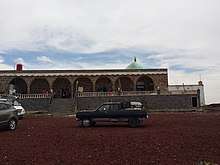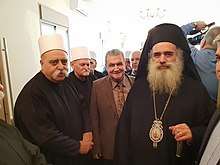Christianity and Druze
Christianity and Druze are Abrahamic religions that share a historical traditional connection with some major theological differences. The two faiths share a common place of origin in the Middle East, and consider themselves to be monotheistic.

Christianity is an Abrahamic monotheistic religion based on the life and teachings of Jesus of Nazareth. Its adherents, known as Christians, believe that Jesus is the Christ, whose coming as the messiah was prophesied in the Old Testament, and chronicled in the New Testament.[1] The primary scriptures of Christianity is the Bible.[2] It is the world's largest religion with about 2.4 billion followers.[3]
Jethro of Midian is considered an ancestor of Druze, who revere him as their spiritual founder and chief prophet.[4][5][6][7][8] It is a monotheistic and Abrahamic religion based on the teachings of Hamza ibn-'Ali ibn-Ahmad and the sixth Fatimid caliph Al-Hakim bi-Amr Allah, and Greek philosophers such as Plato, Aristotle, Pythagoras, and Zeno of Citium.[9][10] The Epistles of Wisdom is the foundational text of the Druze faith.[11] Even though the faith originally developed out of Ismaili Islam, Druze do not identify as Muslim.[12][13] The number of Druze people worldwide is between 800,000 and one million, with the vast majority residing in the Levant.[14]
Religious comparison
In terms of religious comparison, mainstream Christian denominations do not believe in reincarnation or the transmigration of the soul, contrary to the beliefs of the Druze.[15] Where the reincarnation is a paramount tenet in the Druze faith.[16] Christianity teaches evangelism, often through the establishment of missions, unlike the Druze who do not accept converts to their faith. Marriage outside the Druze faith is rare and is strongly discouraged. Similarities between the Druze and Christians include commonalities in their view of monogamous marriage and divorce, as well as belief in the oneness of God and theophany.[15] The Druze faith incorporates some elements of Christianity,[17][18] and other religious beliefs.
Both faiths give a prominent place to Jesus:[19][20] Jesus is the central figure of Christianity, and in the Druze faith, Jesus is considered an important prophet of God,[19][20] being among the seven prophets who appeared in different periods of history.[21] Both religions venerated John the Baptist,[22] Saint George,[23] Elijah,[24] and other common figures.
History

The relationship between the Druze and Christians has been characterized by harmony and coexistence,[25][26][27][28] with amicable relations between the two groups prevailing throughout history, with the exception of some periods, including 1860 Mount Lebanon civil war.[29][30] Fakhr-al-Din II (1572 – 1635) was a Druze prince and a leader of the Mount Lebanon Emirate. Maronite Abū Nādir al-Khāzin was one of his foremost supporters and served as Fakhr-al-Din's adjutant. Phares notes that "The emirs prospered from the intellectual skills and trading talents of the Maronites, while the Christians gained political protection, autonomy and a local ally against the ever-present threat of direct Ottoman rule.[31] After the Shehab dynasty converted to Christianity, the Druze lost most of their political and feudal powers. Also, the Druze formed an alliance with Britain and allowed Protestant Christian missionaries to enter Mount Lebanon, creating tension between them and the native Maronite Church. Approximately 10,000 Christians were killed by the Druze during inter-communal violence in 1860.[32]
The members of the Christian communities (Maronites, Eastern Orthodox, Melkite Catholic, and others) mixed with the Unitarian Druze, led to the presence of mixed villages and towns in Mount Lebanon, Jabal al-Druze,[33] the Galilee region, and Mount Carmel. The Maronite Catholic and the Druze founded modern Lebanon in the early eighteenth century, through the ruling and social system known as the "Maronite-Druze dualism" in Mount Lebanon Mutasarrifate.[34]
A number of the Druze embraced Christianity, such as some of Shihab dynasty remembers,[35] as well as the Abi-Lamma clan.[36] During the nineteenth and twentieth centuries, Protestant missionaries established schools and churches in Druze strongholds, with some Druze converting to Protestant Christianity;[37] yet they did not succeed to convert Druze to Christianity en masse. On the other hand, many Druze immigrants to the United States converted to Protestantism, becoming communicants of the Presbyterian or Methodist Churches.[38][39] According to the Druze religious courts, between 1952 to 2009, around 10% of Israeli Druze who left the Druze faith converted to Christianity.[40]
By one estimate made by Elisabe Granli from University of Oslo, around 1,920 Syrian Druze converted to Christianity;[41] according to the same study, Christians with a Druze background (Druze converts to Christianity) still regard themselves as Druze,[42] and claim that there is no contradiction between being Druze and being Christian.[43]
References
- Woodhead, Linda (2004). Christianity: A Very Short Introduction. Oxford: Oxford University Press. pp. n.p.
- Olson, The Mosaic of Christian Belief.
- "World's largest religion by population is still Christianity". Pew Research Center. Retrieved 27 February 2019.
- Corduan, Winfried (2013). Neighboring Faiths: A Christian Introduction to World Religions. p. 107. ISBN 978-0-8308-7197-1.
- Mackey, Sandra (2009). Mirror of the Arab World: Lebanon in Conflict. p. 28. ISBN 978-0-393-33374-9.
- Lev, David (25 October 2010). "MK Kara: Druze are Descended from Jews". Israel National News. Arutz Sheva. Retrieved 13 April 2011.
- Blumberg, Arnold (1985). Zion Before Zionism: 1838–1880. Syracuse, NY: Syracuse University Press. p. 201. ISBN 978-0-8156-2336-6.
- Rosenfeld, Judy (1952). Ticket to Israel: An Informative Guide. p. 290.
- Léo-Paul Dana (1 Jan 2010). Entrepreneurship and Religion. Edward Elgar Publishing. p. 314. ISBN 978-1-84980-632-9.
- Terri Morrison; Wayne A. Conaway (24 Jul 2006). Kiss, Bow, Or Shake Hands: The Bestselling Guide to Doing Business in More Than 60 Countries (illustrated ed.). Adams Media. p. 259. ISBN 978-1-59337-368-9.
- Nejla M. Abu Izzeddin (1993). The Druzes: A New Study of their History, Faith, and Society. BRILL. pp. 108–. ISBN 978-90-04-09705-6. Retrieved 17 March 2011.
- "Are the Druze People Arabs or Muslims? Deciphering Who They Are". Arab America. Arab America. 8 August 2018. Retrieved 13 April 2020.
- James Lewis (2002). The Encyclopedia of Cults, Sects, and New Religions. Prometheus Books. Retrieved 13 May 2015.
- "Druze set to visit Syria". BBC News. 30 August 2004. Retrieved 8 September 2006.
The worldwide population of Druze is put at up to one million, with most living in mountainous regions in Syria, Lebanon, Jordan and Israel.
- Nisan 2002, p. 95.
- Seabrook, W. B., Adventures in Arabia, Harrap and Sons 1928, (chapters on Druze religion)
- Quilliam, Neil (1999). Syria and the New World Order. Michigan University press. p. 42. ISBN 9780863722493.
- The New Encyclopaedia Britannica. Encyclopaedia Britannica. 1992. p. 237. ISBN 9780852295533.
Druze religious beliefs developed out of Isma'ill teachings. Various Jewish, Christian, Gnostic, Neoplatonic, and Iranian elements, however, are combined under a doctrine of strict monotheism.
- Hitti, Philip K. (1928). The Origins of the Druze People and Religion: With Extracts from Their Sacred Writings. Library of Alexandria. p. 37. ISBN 9781465546623.
- Dana, Nissim (2008). The Druze in the Middle East: Their Faith, Leadership, Identity and Status. Michigan University press. p. 17. ISBN 9781903900369.
- A Political and Economic Dictionary of the Middle East. Routledge. 2013. ISBN 9781135355616.
...Druze believe in seven prophets: Adam, Noah, Abraham, Moses, Jesus, Muhammad, and Muhammad ibn Ismail ad-Darazi..
- Swayd, Samy (2015). Historical Dictionary of the Druzes. Rowman & Littlefield. p. 77. ISBN 1442246170.
- Murphy-O'Connor, Jerome (2008). The Holy Land: An Oxford Archaeological Guide from Earliest Times to 1700. OUP Oxford. p. 205. ISBN 9780191647666.
- Swayd, Samy (2015). Historical Dictionary of the Druzes. Rowman & Littlefield. p. 77. ISBN 1442246170.
- Hazran, Yusri (2013). The Druze Community and the Lebanese State: Between Confrontation and Reconciliation. Routledge. p. 32. ISBN 9781317931737.
the Druze had been able to live in harmony with the Christian
- Artzi, Pinḥas (1984). Confrontation and Coexistence. Bar-Ilan University Press,. p. 166. ISBN 9789652260499.
.. Europeans who visited the area during this period related that the Druze "love the Christians more than the other believers," and that they "hate the Turks, the Muslims and the Arabs [Bedouin] with an intense hatred.
CS1 maint: extra punctuation (link) - CHURCHILL (1862). The Druzes and the Maronites. Montserrat Abbey Library. p. 25.
..the Druzes and Christians lived together in the most perfect harmony and good-will..
- Hobby (1985). Near East/South Asia Report. Foreign Broadcast Information Service. p. 53.
the Druzes and the Christians in the Shuf Mountains in the past lived in complete harmony..
- Fawaz, L.T. (1994). An Occasion for War: Civil Conflict in Lebanon and Damascus in 1860. University of California Press. ISBN 9780520087828. Retrieved 2015-04-16.
- Vocke, Harald (1978). The Lebanese war: its origins and political dimensions. C. Hurst. p. 10. ISBN 0-903983-92-3.
- O'Mahony, Anthony; Loosley, Emma (16 December 2009). "Eastern Christianity in the Modern Middle East". Routledge – via Google Books.
- "Lebanon". Library of Congress Country Studies. December 1987. Archived from the original on 31 July 2018. Retrieved 14 April 2019.
- The Druze and Assad: Strategic Bedfellows
- Deeb, Marius (2013). Syria, Iran, and Hezbollah: The Unholy Alliance and Its War on Lebanon. Hoover Press. ISBN 9780817916664.
the Maronites and the Druze, who founded Lebanon in the early eighteenth century.
- Mishaqa, p. 23.
- Gábor Ágoston; Bruce Alan Masters (2009-01-01). Encyclopedia of the Ottoman Empire. Infobase Publishing. p. 530. ISBN 978-1-4381-1025-7. Retrieved 2013-05-25.
- A. Kayyali, Randa (2006). The Arab Americans. Greenwood Publishing Group. p. 21. ISBN 9780313332197.
some Christians (mostly from the Orthodox faith), as well as Druze, converted to Protestantism...
- A. Kayyali, Randa (2006). The Arab Americans. Greenwood Publishing Group. p. 21. ISBN 9780313332197.
Many of the Druze have chosen to deemphasize their ethnic identity, and some have officially converted to Christianity.
- Hobby, Jeneen (2011). Encyclopedia of Cultures and Daily Life. University of Philadelphia Press. p. 232. ISBN 9781414448916.
US Druze settled in small towns and kept a low profile, joining Protestant churches (usually Presbyterian or Methodist) and often Americanizing their names..
- Druze Identity, Religion – Tradition and Apostasy
- Granli, Elisabet (2011). "Religious conversion in Syria : Alawite and Druze believers". University of Oslo.
- Granli, Elisabet (2011). "Religious conversion in Syria : Alawite and Druze believers". University of Oslo.
- Granli, Elisabet (2011). "Religious conversion in Syria : Alawite and Druze believers". University of Oslo.
Further reading
- R. J. Mouawad, Les Maronites. Chrétiens du Liban, Brepols Publishers, Turnhout, 2009, ISBN 978-2-503-53041-3
- Kamal Salibi, A House of Many Mansions: The History of Lebanon Reconsidered (University of California Press, 1990).
- Dr. Anis Obeid: The Druze & Their Faith in Tawhid, Syracuse University Press (July 2006). ISBN 0-8156-3097-2.
- Shamai, Shmuel (1990). "Critical Sociology of Education Theory in Practice: The Druze Education in the Golan". British Journal of Sociology of Education. 11 (4): 449–463. doi:10.1080/0142569900110406.
- Samy Swayd The Druzes: An Annotated Bibliography, Kirkland, Washington: ISES Publications (1998). ISBN 0-9662932-0-7.
- Nisan, Mordechai (2002), Minorities in the Middle East: a history of struggle and self-expression (2nd, illustrated ed.), McFarland, ISBN 978-0-7864-1375-1, retrieved 4 April 2012.